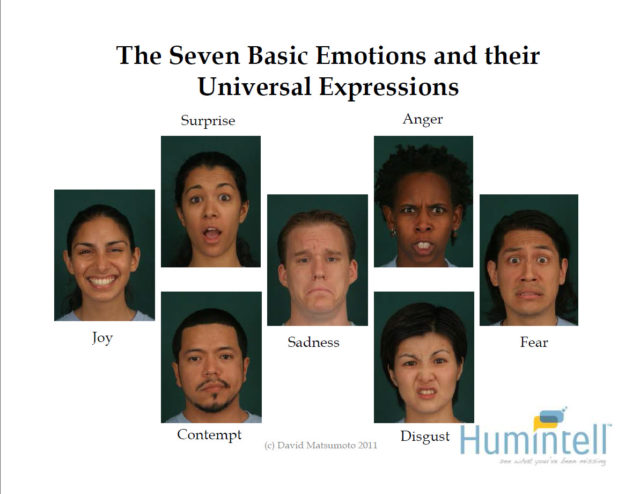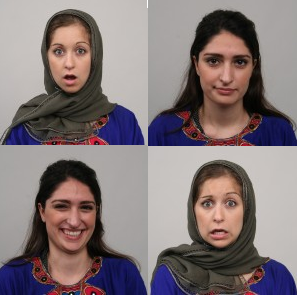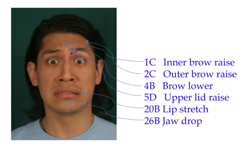Did you miss Dr. Matsumoto’s free microexpressions webinar on February 3rd?
Don’t worry, you can watch the entire recording below!
Universal Facial Expressions
 Any discussion of microexpressions starts with a large acknowledgement to the fact there are seven facial expressions of emotion that research has shown to be universally expressed and recognized.
Any discussion of microexpressions starts with a large acknowledgement to the fact there are seven facial expressions of emotion that research has shown to be universally expressed and recognized.
The original universality research has led to decades of further research documenting the universality of the expression and recognition of these facial expressions of emotion.
Today the area of emotion research is also known as the field of affective sciences and these areas of research are huge not only in psychology, but other social sciences as well.
The Benefit of Reading Facial Expressions of Emotion
 There have been so many studies over the last few decades that have demonstrated and documented the importance of being able to read facial expressions of others.
There have been so many studies over the last few decades that have demonstrated and documented the importance of being able to read facial expressions of others.
This research has documented those benefits within
- Families
- Social groups
- Work settings
- Clubs
One of the biggest reasons why facial expressions are so important is because they serve the purpose of communication.
We see other people’s facial expressions of emotion and we have an idea of:
- What’s going on in their mind
- The social meaning about whatever they’re emotional about
- Their intentions and motivations
All of this serves the purpose of communication, just like words.
If you follow the evolutionary history of humans, facial expressions of emotion occurred in non-human primates before language. They are the original language (albeit nonverbal) that we have to allow for social coordination.
The main purpose of all communication (verbal and nonverbal) is to share our intentions. By sharing our intentions with each other, that’s how we can build on our societies and cultures.
The ability to share our intentions to the extent that we can as humans by language is further augmented by facial expressions of emotion. Without the ability to share our intentions, we would have social chaos.
What about Microexpressions?
Microexpressions are a very special type of facial expression of emotion and were first discovered by Haggard and Isaacs (1966).
In their study, Haggard and Isaacs outlined how they discovered these “micromomentary” expressions while scanning motion picture films of psychotherapy hours, searching for indications of non-verbal communication between patient and therapist.
Microexpressions are very different- expressions that occur under 1/2 a second. Often times it is very difficult for people to see them or even if they are seen, people don’t know how to interpret them.
It doesn’t seem that people in human societies need to be able to see microexpressions for us to generally get along. Often times people miss them or if they see them, they don’t know how to interpret them. Despite this fact, humans are thriving all around the world. For the survival of the species and social coordination as a whole, we probably don’t need to see microexpressions.
However, some of us may want to have that ability. Especially those who are in professions where they interview others professionally where they want that extra edge to understand others’ thoughts and feelings.
We know from our research and from our training that we can learn to see microexpressions.
Microexpression Training Development and Validation
Humintell’s microexpression training tools have gone through many steps for development and validation.
These steps include:
1. Image Creation
 Researchers have measured exactly which muscles are activated when people are spontaneously experiencing and expressing an emotion. If people all around the world experience an emotion and express it spontaneously, the same muscles on their face are activated.
Researchers have measured exactly which muscles are activated when people are spontaneously experiencing and expressing an emotion. If people all around the world experience an emotion and express it spontaneously, the same muscles on their face are activated.
These muscles are measured and thus, the specific muscles and their combinations that correspond to the seven basic emotions is known and validated by science.
This first step called image creation involved hiring a broad range of actors. Each actor was taught to move the specific muscles corresponding to each emotions.
Thousands of photos were taken from individuals representing 6 different ethnic groups and both genders (male and female).
2. Preliminary image selections
This process involved sorting through the thousands of photos that were taken to see which ones were usable and which ones are not.
3. FACS coding and validation

After the images were selected, they were FACS coded. FACS stands for the facial action coding system. Each image was coded according to which muscles were activated on the face.
The validation procedure began once the images have been FACS coded. They were matched to the appropriate emotion based on decades of research which has outlined which specific muscles are activated when a spontaneous facial expression of emotion is elicited. Each image was matched to their corresponding emotion based on their FACS codes.
4. Selections for balance across sections
This step involved matching the intensity of the emotion as well as matching for gender and ethnicity for each section of the training.
5. Structure of the training
The overall structure of the online training: pre-test, instruction, practice, review, and post-test was based on learning pedagogy. There is substantial training development literature that demonstrates that this course format is the best way to train any skill.
Live Q&A
At the end of the webinar Dr. Matsumoto answered live questions as well as questions that were previously submitted via email.
Q from yesterday’s #webinar:
Is there is potential developmental harm that is being caused to infants & toddlers who do not get to see their caregivers’ and teachers’ mouths nor see their full facial expressions as a result of mask wearing?My answer: pic.twitter.com/GdSFaNzEta
— David Matsumoto (@davidmatsumoto) February 4, 2022